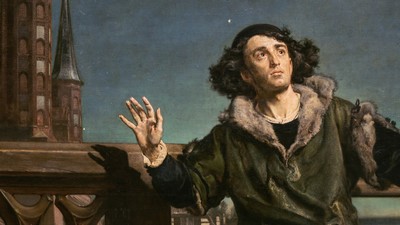Conversations with God:
Jan Matejko’s Copernicus
National Gallery, London
25 March – 27 June 2021
Copernicus. Conversations with God, 1873
Jagiellonian University, Kraków
© Photo courtesy the owner
In spring 2021, an iconic painting of astronomer Nicolaus Copernicus, by the most famous Polish painter of the 19th century, Jan Matejko, will make a rare visit to the National Gallery, the first time it will ever have been seen in the UK.
The 10-foot wide painting, which rarely leaves its home in the Senate Chamber of the Jagiellonian University, Kraków, will be part of a new exhibition introducing visitors to the work of Jan Matejko (1838–1893). Despite being largely unknown outside his homeland, this highly original and distinctive artist is widely regarded as the national painter of Poland.
Jan Matejko, (pronounced Ma – tay – coe), is revered by Poles for his huge, teeming, minutely detailed depictions of key moments in the nation's history. This particular work celebrates the achievements of Polish astronomer Copernicus (1473–1543), the first person since the ancient Greeks to realise that the sun rather than the earth is at the centre of our planetary system and that we revolve around it.
The monumental canvas was painted in 1873 to mark the 400th anniversary of the astronomer’s birth. Rather than depicting Copernicus at the moment of his discovery of heliocentrism – in the painting his chart of the heavens can already be seen there by his side – Jan Matejko chose to paint him on a rooftop in his hometown of Frombork discussing the matter with God. Unlike Galileo, some 73 years later, who reached similar conclusions but who alienated the Catholic Church, Copernicus was never excommunicated for challenging traditional belief; indeed, enlightened clerics of the day celebrated his breakthrough.
This painting of a genius at work achieved almost instant fame when it was first exhibited in Kraków. It was circulated in thousands of reproductions and was subsequently acquired by subscription for the Jagiellonian University in 1873.
At the time Poland was still partitioned and debate raged about the nationality of Copernicus with both Germany and Poland claiming the astronomer as their own. This painting, showing him kneeling awestruck against a starry sky on the rooftop of the Tower at Frombork near the city’s cathedral where he served as canon, clearly positions Copernicus as Polish, thereby striking a chord with Polish people then in search of national figureheads and the work became both a symbol of Polish cultural identity and a vehicle for Polish nationalism.
The exhibition will include a copy of Copernicus’s 'De revolutionibus orbium coelestium', 'On the Revolutions of the Celestial Spheres', published in 1543 (National Maritime Museum, Greenwich, London) which marked a turning point in human understanding of our place in the universe, together with astronomical instruments (The Jagiellonian University Museum, Kraków) and a self portrait and study for 'Copernicus, Conversations with God' (The National Museum in Kraków).
Christopher Riopelle, The Neil Westreich Curator of Post-1800 Paintings at the National Gallery, says: ‘Matejko saw his role not merely as recording great events from Polish history but at expressing their deep inner meaning for Poles. He stands at the end of the long tradition of history painting and, as the wider world is re-discovering, was one of its most ingenious and provocative exponents.’
Dr Gabriele Finaldi, Director of the National Gallery, says: ‘This is the second in a series of exhibitions supported by the Capricorn Foundation, in memory of Mr H J Hyams, and brings one of Poland’s most famous pictures to the National Gallery. Matejko’s Copernicus demonstrates the artist’s ambition to create defining images for a nation that yearned to recover its sovereignty and independence.’
THE NATIONAL GALLERY
Trafalgar Square, London WC2N 5DN

